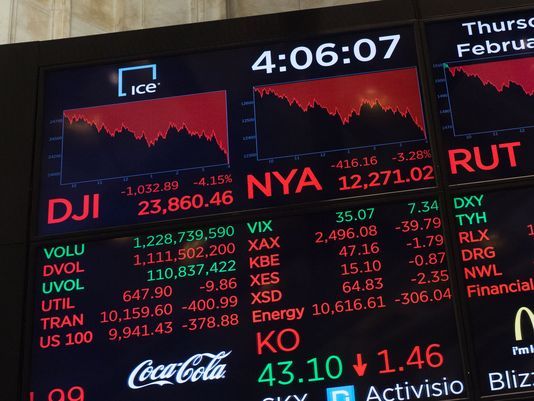
It’s time to pop a Maalox.
Blame the plunging Dow. The blue-chip stock average is trying to make a habit of daily 1,000-point dives. This past week it briefly fell more than 10% from its January all-time high, a swift sell-off that has investors on edge.
Wall Street pros say that such a drop, dubbed a “correction,” is normal. They say that they are healthy. That they flush the froth and irrational exuberance out of overheated markets.
All true.
But that doesn’t mean these downturns aren’t worrisome events that cause investors to wonder if their money is safe.
“Investors are feeling increasingly nervous,” says Terry Sandven, chief equity strategist at U.S. Bank Wealth Management in Minneapolis.
But an emotional investor isn’t an effective one.
Panic isn’t a financial strategy. Corrections don’t mean the Dow is going to zero. In fact, periodic drops of 10% aren’t all bad for investors, especially those with long-term financial goals, investment pros say.
As billionaire investor Warren Buffett always says, the worst times on Wall Street can often be the best times to invest.
“If this isn’t a wake-up call for complacent investors, I’m not sure what is, but that doesn’t mean folks should run for the hills,” says Mike Loewengart, vice president of investment strategy at online broker E-Trade.
To help keep anxiety levels in check and portfolios on track, here’s what 401(k) investors need to know about corrections and how to survive them.
BY THE NUMBERS
For the Standard & Poor’s 500 stock index, the average correction drop has been 14%, based on 21 events since 1945, according to data from CFRA, a Wall Street research firm. Heading into Friday, the broad market gauge was down 10.2% from its Jan. 26 all-time high. The takeaway: If history is a guide, the market is getting close to a bottom.
Corrections, or drops of 10% to 19.99%, take about five months, on average, before hitting a low, CFRA data show. And it takes four months, on average, to get back to the market’s previous highs.
These highly publicized declines are also more frequent than investors may realize. They’ve occurred about once a year since 1928, according to Bespoke Investment Group.
The fact that the market hasn’t tumbled 10% since February 2016 adds to the angst.
“Investors have now had a taste of fear of loss, which hasn’t happened in a long time,” says Stephen Janachowski, president and CEO of wealth management firm Brouwer & Janachowski in Mill Valley, Calif.
CORRECTION PROS
Corrections actually bode well for investors longer term, says Ann Miletti, a lead equity portfolio manager at Wells Fargo Asset Management, who says this downturn could push prices 15% lower.
Big sell-offs turn pricey stock markets into less expensive ones. “Corrections keep valuations in check,” Miletti says.
The market’s price-to-earnings ratio, a common measure to determine if the market is cheap or expensive, has dropped from 18.7 times the S&P 500’s expected earnings at the January market peak to 16.4 after Thursday’s rout, according to earnings-tracker Thomson Reuters. The market is now trading closer to its long-term average P-E of around 15.
Investors who were in a buying mood before stocks hit the skids will now find their favorite stocks at lower prices. “It gives investors a chance to buy quality stocks at cheaper prices,” Miletti says.
Some well-known stocks are more attractively priced. Apple was down 16% from its January peak heading into Friday’s trading action, while Home Depot was off 14.6% and Visa was 13% lower.
While the S&P 500 is only about halfway to a bear market, 96 of those 500 stocks were down more than 20% from their highs, as of Thursday’s close, putting them in bear territory, according to FactSet data.
“The timing may not be bad,” Miletti says. “If you didn’t invest in your 401(k) last year you may be getting the chance to do it at a discount.”
CORRECTION CONS
The main negative of a correction is that 401(k) investors see a decline in their account balances. And the market uncertainty causes them to wonder if stocks will go even lower. Wall Street chatter about a possible coming bear market, adds to their angst.
Headlines about plunging markets, however, don’t necessarily add up to losses in 401(k) portfolios that are as large as one might fear, at least not yet. For example, while the market is down 8.8% from its late January record after Friday’s rally, it is off just 2% from the beginning of the year.
That means an investor who had $100,000 in the S&P 500 at the end of 2017, still has $98,000 in their account. That’s hardly a reason to bail out of stocks. And investors with a portfolio made up of stocks, bonds and cash are now sitting on even smaller losses.
The violent price drops that accompany corrections are often a potential indication of a changing market environment.
“Corrections have causes,” says Tom Essaye, founder of The Sevens Report, an investment newsletter. “Something happens to change the outlook.”
For now, however, despite fear that rising interest rates are a threat to the market, Wall Street still hasn’t seen signs that the sell-off is a result of a weakening economy.
“That’s a positive,” Essaye says.

